Positive displacement flowmeters measure flow rate through the continuous filling and emptying of a chamber of known volume. Positive displacement flowmeters differ from positive displacement pumps only in that, rather than being driven by motors, they are driven by the fluid flowing through them.
Positive displacement flowmeters are some of the most accurate flowmeters available today. They can easily obtain flow measurements within 0.1% of the true value. They are unique because they are the only type of flowmeter that directly measures the volumetric flow rate.
Additionally, positive displacement flowmeters require no power and are capable of handling high pressures, entrained gases, and suspended solids. The main disadvantage of positive displacement flowmeters is that they are extremely expensive to install and maintain due to their many moving parts.
Each type of positive displacement flow meters in this page generally contains general information, equipment design, usage examples, and advantages/disadvantages.
Oval Gear & Impeller
General Information/Equipment Design
Oval gear meters and impeller meters, shown below, operate in the same manner, but differ in the shape of the gears. Fluid flowing through the measuring chamber causes the gears to turn, displacing an exact volume of fluid. A magnetic or mechanical device counts the number of turns, determining the volumetric flow rate.

(Copyright Badger Meter, Inc., Milwaukee, WI)

(Copyright FTI Flow Technology Inc., Tempe, AZ)
Usage Examples
The industrial oval gear meters pictured on the left are used for a variety of applications including petroleum-based fluids, water solutions, and liquids compatible with the materials of construction. Pictured on the right is a handheld oval gear meter that is used in applications that require an accurate measurement of dispensed liquid volume. Examples of applications include petroleum, chemical, fuel management, lubrication, solvents, and food product industries.
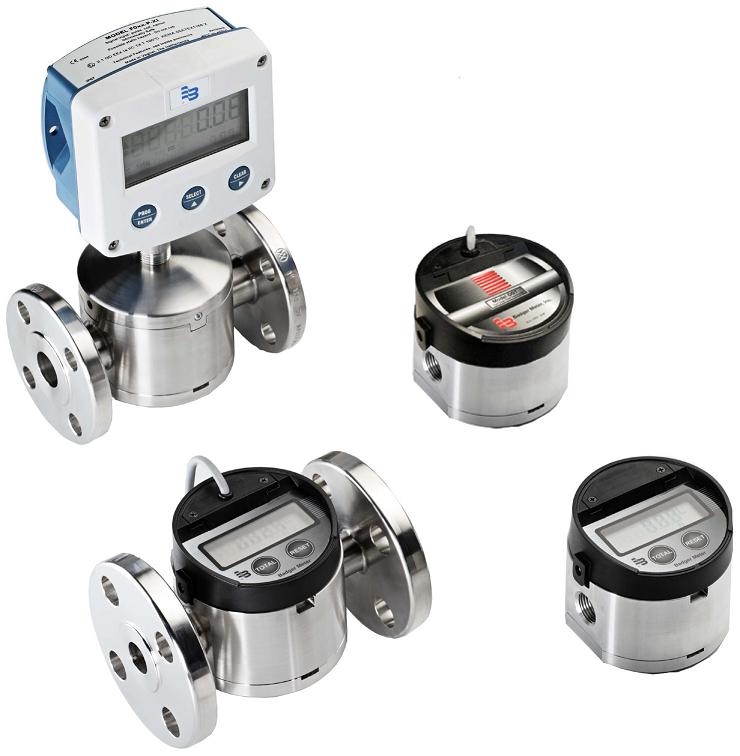
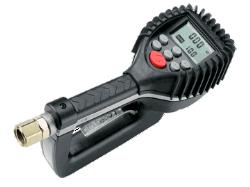
(Copyright Badger Meter, Inc., Milwaukee, WI)
Advantages
- High accuracy and repeatability
- Handles viscous flow
- Cost-effective
- Accuracy unaffected by changes in viscosity
- Requires little maintenance
Disadvantages
- Typical construction materials are susceptible to corrosion by water-based fluids
Helical Rotor
General Information/Equipment Design
In helical rotor meters, two nested rotors create pockets of fixed volume. The counter-rotation of the rotors carries the pockets of liquid axially down the length of the rotors. The rotation rate and the number of rotations, determined by the flow rate, are measured using electronic sensors. Helical rotor meters are made of cast iron, cast steel, or bronze depending on the material flowing through it.

(Copyright Flowserve Corporation, Irving, TX)
Usage Examples
Common applications of the helical rotor meter involve the measurements of highly viscous materials such as concrete or molasses. Pictured below is an example of one of these meters.

Advantages
- Especially well suited for measurement of highly viscous and hard-to-meter fluids.
- Highest accuracy and repeatability of any positive displacement flowmeter.
- Unaffected by flow profile and does not require straight lengths of pipe.
- Low-pressure drop.
- Rotor action is self-cleaning
Disadvantages
- Can only meter liquids.
- Typical materials of construction will corrode in the presence of water or water-based fluids.
- Cannot handle abrasive fluids.
Rotary Vane
General Information/Equipment Design
A rotary vane meter is composed of a circular rotor mounted inside a round compartment that contains a number of sliding vanes, which isolate fixed volumes of liquid between the rotor and the wall of the compartment. The center of the rotor is offset from that of the compartment. This keeps the rotor in constant contact with the wall of the compartment opposite that of the liquid pockets, to prevent backwashing. The more vanes in the rotor, the higher the accuracy of a rotary vane meter at low flow rates.
Usage Examples
Rotary vane meters are often used in the petroleum and agricultural industries due to their rugged construction. As with many positive displacement flowmeters, they also function as batchers.
Advantages
- Sweeping action of vanes prevents buildup of sediment and keeps the compartment clean.
- Wide choice of construction materials.
- High accuracy and repeatability.
- Low-pressure drop over the entire range of flow measuring capabilities.
Disadvantages
- Relatively complex design increases cost.
Rotary
General Information
A rotary vane meter is composed of a circular rotor mounted inside a round compartment that contains Rotary positive displacement meters are similar to rotary vane meters but operate with rotors, as opposed to sliding vanes, that rotate in unison within the measuring chamber.
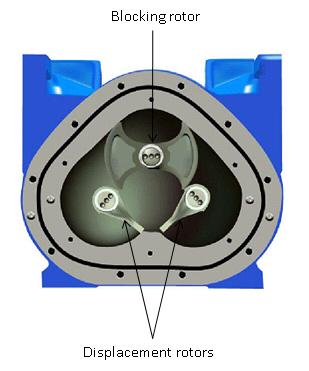
Equipment Design
As fluid flows into the chamber, the blocking rotor is forced to rotate and the movement of the fluid is translated from linear motion to rotational motion. The displacement meters rotate with the blocking meter to guide the fluid through the chamber. The blocking meter’s rotation determines the output of the meter and is transmitted to a register.

There is no metal-to-metal contact between the rotors and housing walls, which prolongs the life of the flowmeter.
Pictured below are two commonly used rotary flowmeters.

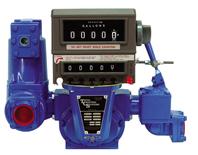
(Copyright Total Control Systems, Fort Wayne, IN)
Usage Examples
Rotary flowmeters are used for the measurement of a variety of fluids including gasoline, oils, liquefied petroleum gas, industrial chemicals, solvents, corn syrup, and adhesives. Pictured below is a rotary flowmeter used to meter refined petroleum products.

Reciprocating Piston
General Information/Equipment Design
Fluid enters a reciprocating piston meter, also known as an oscillating piston meter, through an inlet port. The port leads to a precisely measured gap created by a piston in a round chamber. As the piston oscillates around the chamber, it displaces an exact volume of fluid.
Electromagnetic sensors outside the meter detect the rotation of a magnet inside the center of the piston, which indicates the quantity or rate of fluid passing through the meter. Below is a picture of a reciprocating piston meter.

Usage Examples
The piston meter to the left is part of a system that handles diesel exhaust fluid. In the middle picture, a piston meter is used in renewable fuel applications. Piston meters are good for low volume measurement applications such as fueling light aircraft and helicopters, shown on the right. Other industries that use these flowmeters include chemical, pharmaceutical, petrochemical, and food and beverage.
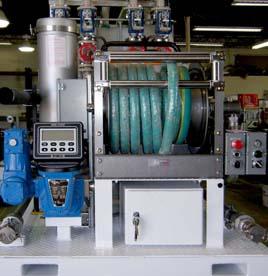
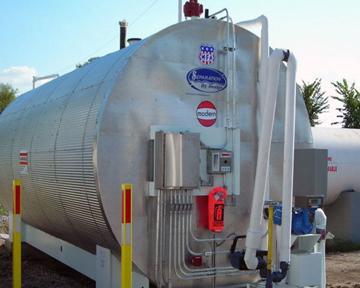
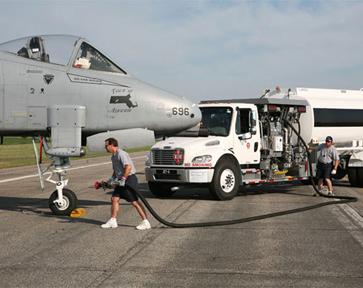
(Copyright Total Control Systems, Fort Wayne, IN)
Advantages
- High accuracy and repeatability.
- Only one moving part to cause wear.
- Can be made of materials to ensure sanitary needs of food and beverage processing.
Disadvantages
- Can only be used with relatively clean liquids.
Nutating Disc
General Information/Equipment Design
A disc attached to a sphere is mounted inside a spherical chamber. As fluid flows through the chamber, the disc, and sphere unit nutates. The nutation causes a pin, mounted on the sphere perpendicular to the disc, to rock. Each revolution of the pin indicates a fixed volume of liquid has passed. A mechanical or electromagnetic sensor detects the rocking of the pin.

Usage Examples
The nutating disc meter below is manufactured to handle hot water up to 250°F. It has a liquid-crystal polymer disc and a bronze housing. Disc meters made with aluminum or bronze discs are commonly used to meter hot oil and chemicals.
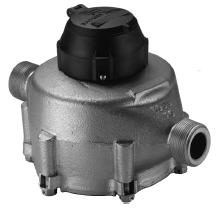
Advantages
- May be constructed from a variety of materials.
- High accuracy and repeatability.
Disadvantages
- Accuracy is adversely affected by viscosities below the meter’s designated threshold.
Acknowledgements
- Badger Meter, Inc., Milwaukee, WI
- Flowserve Corporation, Irving, TX
- FTI Flow Technology Inc., Tempe, AZ
- Total Control Systems, Fort Wayne, IN
References
- Digiacomo, Ronald W., “Measuring Flow.” Chemical Engineering, 7(2011): 30 – 34.
- “Engineering Manual: 700 Series Rotary Flow Meter.” Total Control Systems. Total Control Systems, 2007. Web. 10 July 2011. <https://www.tcsmeters.com/pdf/700/tcs900005.pdf>.
- McCabe, Warren L., Smith, Julian C., and Peter Harriot. Unit Operations of Chemical Engineering. New York: McGraw-Hill, 1993: 227. Print.
- Omega Complete Flow and Level Measurement Handbook and Encyclopedia, Vol. 29. USA: Omega Engineering Inc., 1995: Z-8, Z-11 – Z-18. Print.
Developers
- Erica Mauter
- Steve Wesorick
- Kelsey Kaplan
- Andrea Roberts
- Henry Chen
- Fritz Hyde

